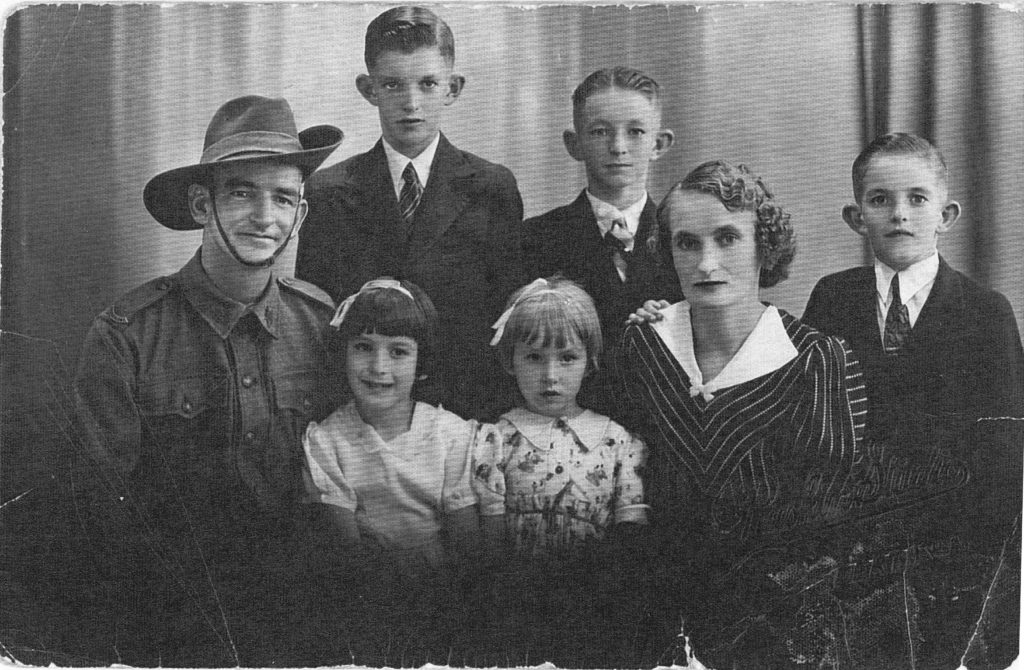The Soldier's Details

- Surname:
- Bevis
- First Name:
- Daniel Edmund
- Nick Name:
- Danny
- Rank:
- Corporal
- Regimental #:
- WX9061
- Company:
- 'C' Company, 11 Platoon
- Enlisted:
- 25.10.1940
- Discharged:
- 15.02.1946
- DOB:
- 21.01.1909
- Place of Birth:
- North Perth, Western Australia
- Father's Name:
- Daniel Bevis
- Mothers's Name:
- Mary Banks Bevis
- Religion:
- Church of England
- Pre-war Occupation:
- Railways Fireman
- Singapore:
- Selarang Camp Changi
- Force:
- 'A' Force Burma, Green Force No. 3 Battalion
- Camps Thailand:
- Tamarkan, Chungkai, Kachu Mountain, Petchaburi, Ratburi, Nacompaton, Bangkok, Nakom Nayok, Lopburi
- Camps Burma:
- Victoria Point, Kendau 4.8km, Thetkaw 14 km, Meiloe 75km, Aungganaung 75 km
- POW#:
- 1368
- Return Details 1945:
- Thailand-Singapore by aircraft Singapore-Fremantle, HMT Tamaroa
General Description
Bevis enlisted AIF 25 Oct 1941. He later joined 2/4th’s ‘C’ Coy becoming Corporal to 11 Platoon under Commanding Officer Lt Boyle.
Sent to work on the Burma-Thai Railway from the Burma end, Danny was sent with 3,000 Australian POWs with ‘A’ Force Burma Green Force No. 3 Battalion. We cannot be certain when he volunteered his services as a medical orderly when the numbers of ill men became overwhelming.
These POWs sailed on three ships to the south-west coast of Burma to first work on repairing and enlarging three aerodromes left by the evacuating British.
Read about Danny Bevis working with Drs’ Claude Anderson (from 2/4th) & Albert Coates, the most senior qualified surgeon of AIF please read further about Coates
Known to the men of ‘A’ Force as ‘Bertie’ – Coates was greatly admired and highly respected by all POWs. After the war had ended and he returned to civilian life, Coates never sought the media or limelight. Like most doctors who gave their all for the sick and dying POWS on the Burma-Thai Railway – he was a strong advocate for former POWs.
From Dr. Claude Anderson, 2/4th MGB
“A few words about tropical ulcers and Col. Coates. He realized that they were all progressive, and as we did not have any effective treatment, all would lead to death. He thought lower third thigh amputations might be useful. A Dutch chemist, Capt.van Boxtel from Java, had a bottle of iodine and a large number of cocaine tablets. He was able to make up a solution which worked as a spinal anaesthetic. Amazingly, Col Coates had .a needle for spinal injections. When I arrived at the hospital they were ready to start the amputations and Col. Coates asked me to assist him. In the next six weeks, before I went back to my job on the railway line, he amputated about 60 legs. The scheme worked fairly well” (although many still died). “Occasionally the Japs killed a yak for the POW. Col Coates arranged to be notified of the yak killings, and he removed strips from the outer surface of intestines. These strips, about the diameter of a thin piece of knitting wool, were then washed and placed in a bottle of iodine, where after 7 days they were thought suitable for use as catgut. I thought this was a brilliant project”.
Claude had a number of men who assisted him as medical orderlies. They included Bob Ritchie (Kojonup), Danny Bevis (Merredin) and Eric Baker. Ritchie was awarded the BEM.
From Claude Anderson’s interview with Winstanley.
Follow the link below to read Peter Winstanley’s article on Captain Claude L Anderson WX3464 Medical Officer 2/4 Machine Gun Battalion
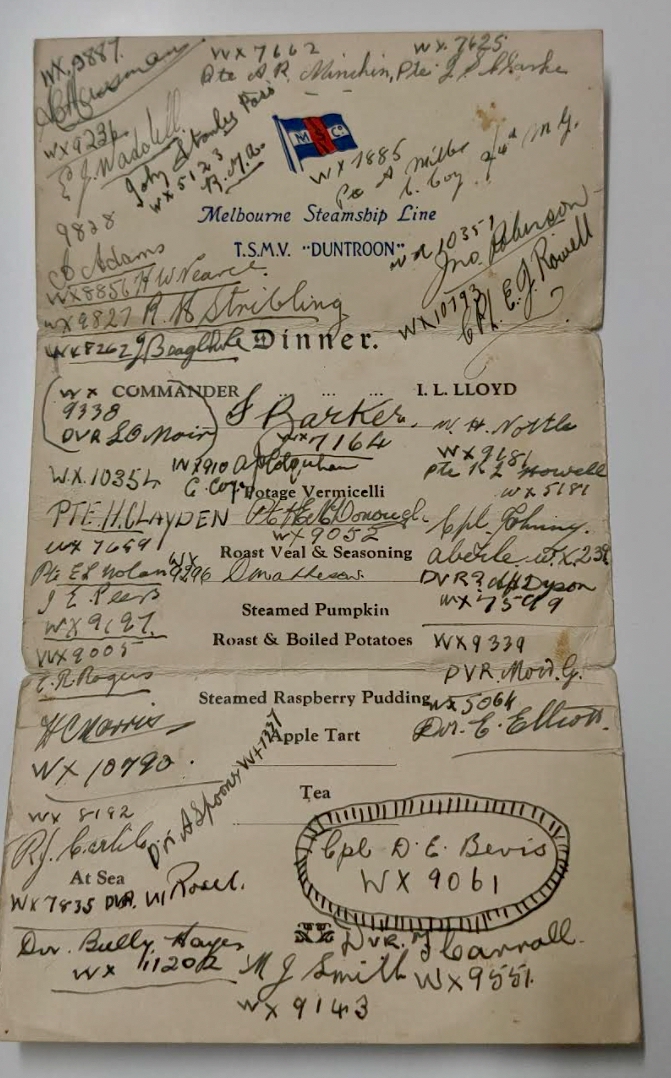
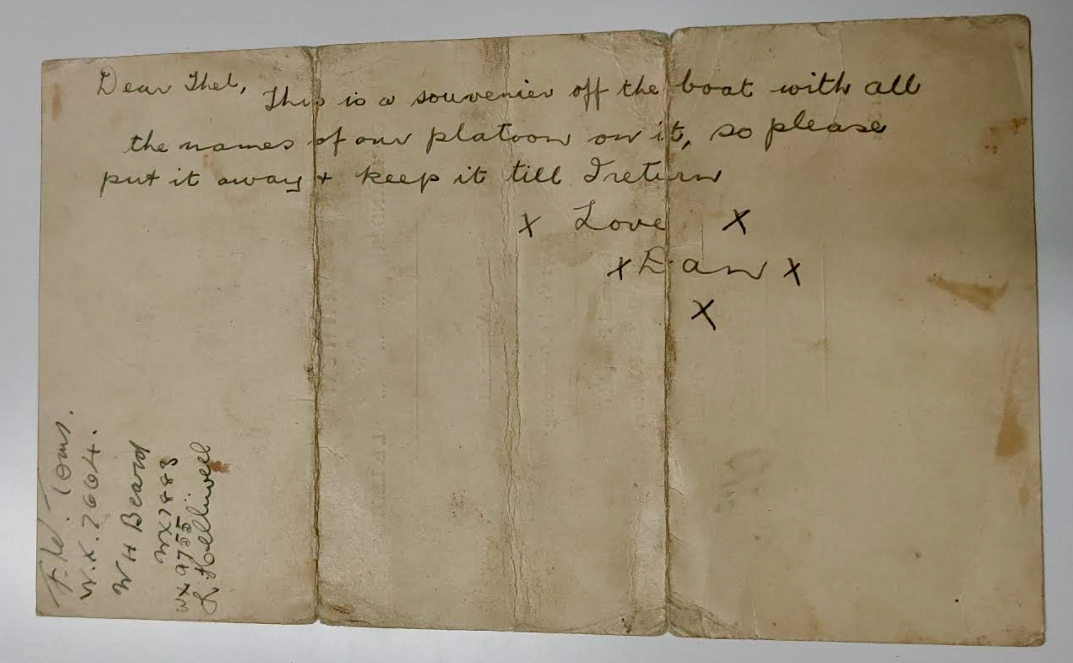
A note written by Danny to his wife Thel, asking her to keep the Menu from the ship Duntroon, 1941. It is in fact the signatures of all the men of ‘C’ Coy, 11 Platoon – a large number of whom did not live to return to their homeland – including these 16 men of 39: Mussman, Minchin, Jim Clarke, Climie, Arthur Adams, Cousins, Norm Fraser, Cpl Foxall, Norm Gibson, McDonough, Harry Pearce, Charlie Roberts, Cpl Rowell, Dudley Squire, Toms, Werrett (and Reinforcement A.T. Cunningham who is not listed).
Please look photograph of 11 Platoon.
Dan and Thelma Bevis with their children L-R Mervyn, Desmond, Trevor, Beryl and Glenis.
Danny and Thelma Jesson married at Northam about 1927.

Danny’s son Merv plays the same football team as Peter Moate, 2/4th MGB.
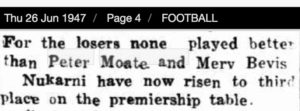
Below: Is this Danny’s father?
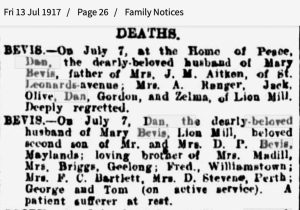
Danny Bevis died 4 years after war’s end in 1949 at Merredin. He was only 40 years old.
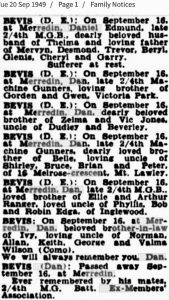
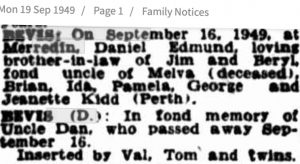
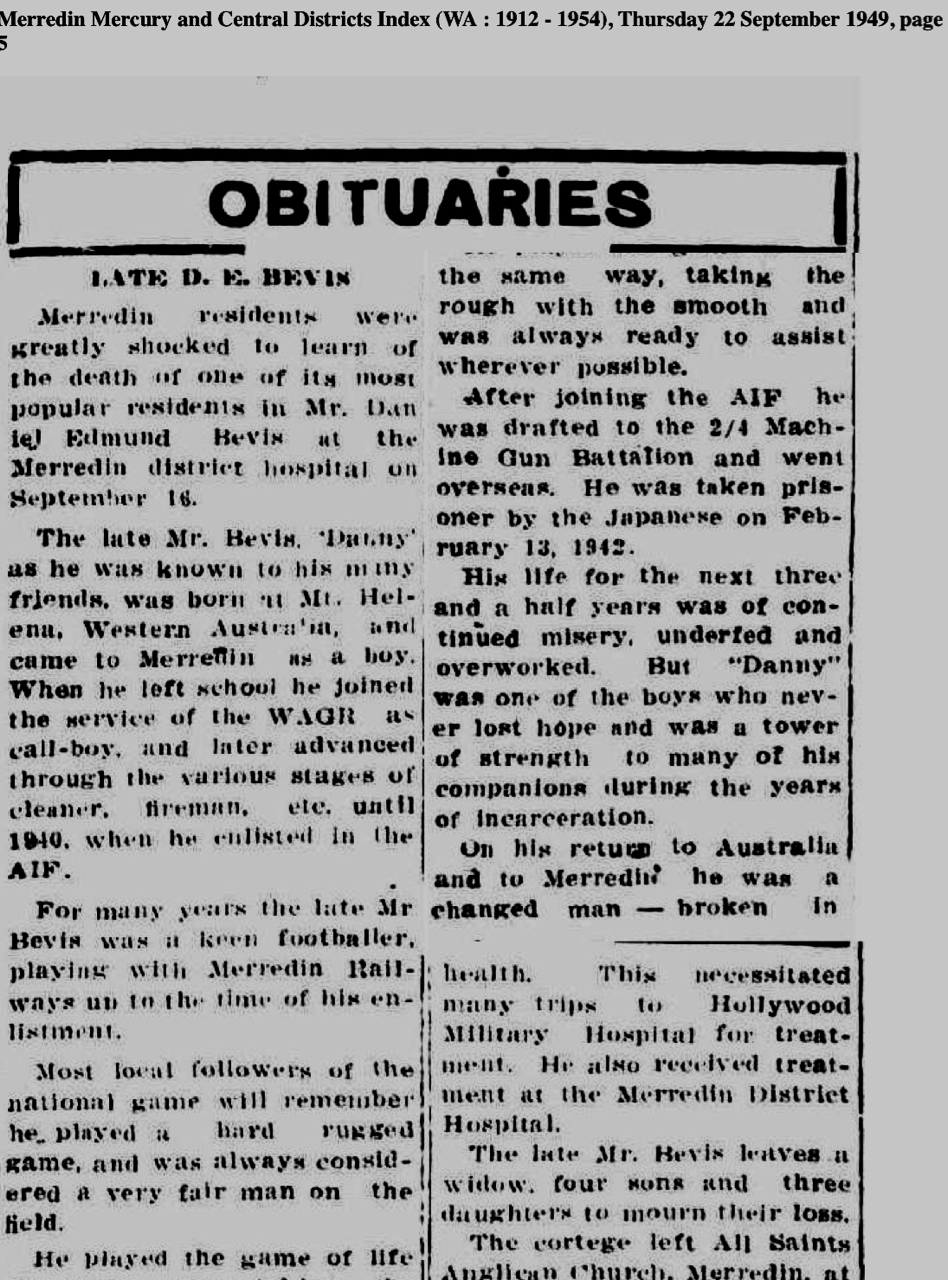
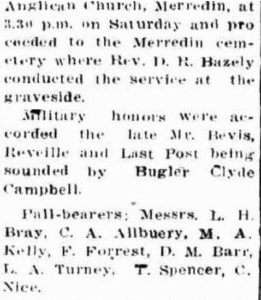
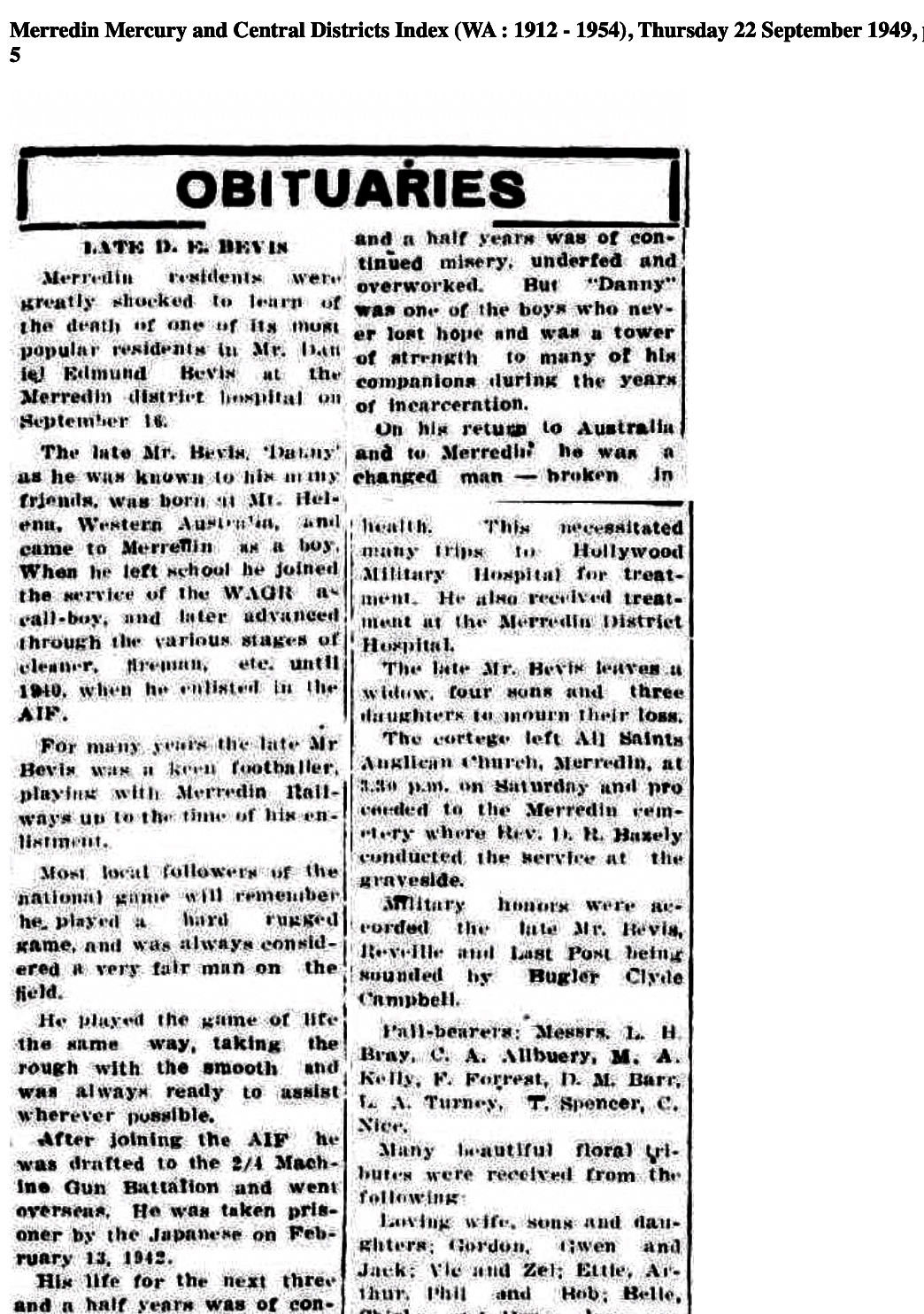
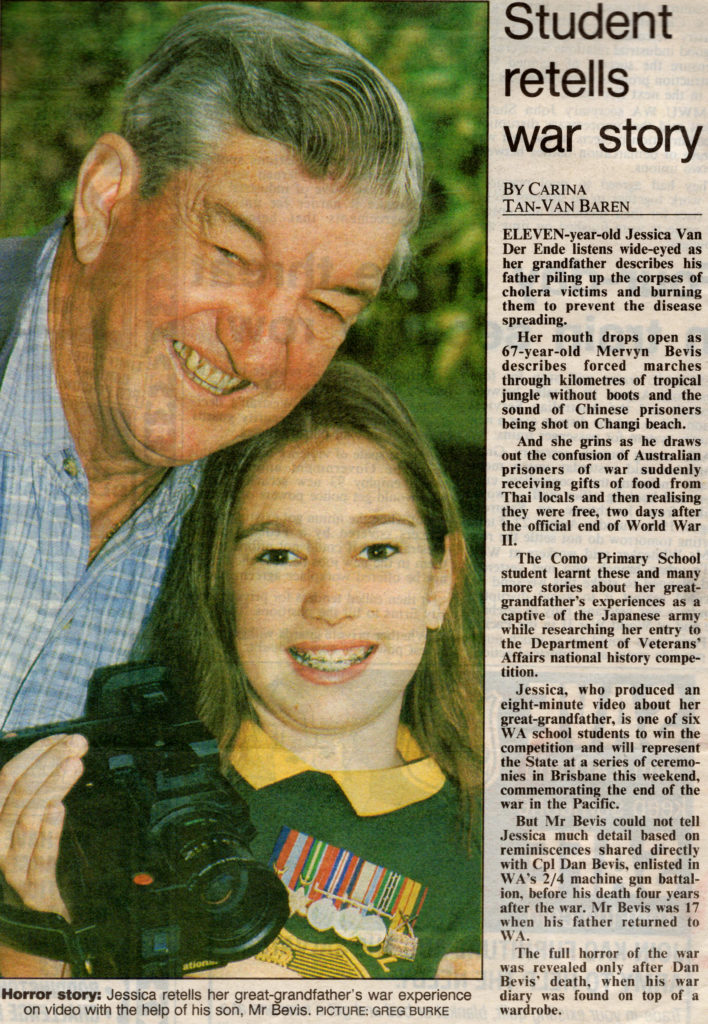
Most of the 2/4th POWs with A Force Burma, Green Force first went to Victoria Point where they worked for several months before making their way to the Burma end of the Rail link.
The following is from Danny’s Diary from the time he arrived in Thailand from Burma, January 1944:
Tamarkan, Thailand 2 Jan 1944 – Bevis arrived as part of the whole contingency plan by the Japanese to move all the POWs in Burma, south to Thailand to one of 4 or 5 large camps or hospitals.
‘Food good for six weeks to build up the Japan Party, later torpedoed. Camp is 60 yards from bridge of eleven steel spans and large AA position. Surrounded by observation posts, Nip engineers, cavalry camp and railway line. Twenty one planes over 29 Nov 1944. Four bombs dropped on camp, 18 killed and 38 wounded.
Non Pladuk ,Thailand 30 Nov 1944 – 62 buildings, workshops, etc. wiped out. Bombs and bullets in camp 93 killed and 310 wounded.
Kanchanaburi, Thailand bombed 13 Dec 1944.
Tamarkan Camp, Thailand
‘Several more raids in December, quiet until 28 Jan 1945. Wooden bridge destroyed and repaired by us. One plane, one bomb, lost one whisky.
5th Feb 1945 – AA half a mile from camp, nip engineers and bridge bombed, 1,000 lb.
23 May 1944 – First Red Cross parcels received. 6 men to one parcel.
28 May 194 – First mail.’
Chungkai Camp, Thailand
‘Left Tamarkan 12 Feb 1945. March over bridge 6 km to Chungkai. Broke all records going over. Arrived same day.
13 Feb 1945 – bridge blown to pieces.
19 Feb 1945 – left Chungkai.’
Non Pladuk Camp, Thailand
‘Arrived 20 Feb 1945. Spent night of expectancy as previous raid very noticeable. Nothing standing except portion of POW Camp. In train four hours before leaving for Kachu Mountain on 21 Feb 1945. Detrained as blown bridge at Ratburi. Thai’s hostile to Nips. Pontoons over river.’
Kachu Mountain, Thailand
‘March to Kachu Mountain 86 km (53 miles). Self picked up in truck 15 miles out (sick with malaria) and arrive Kachu Mountain 22 Feb 1945. The rest (POWs) arrive in a bad way on 24 Feb 1945. Building two aerodromes No. One 8 kms from POW Camp. No. two, 3 kms from POW Camp. (Remember POWS had to work to and from work back to their camps – 8 and 3 kms is a long way when you are sick and exhausted at the end of the day) Conditions and Nips no Good. Self malaria all the time, nearly passed out.
28 April 1945 – 26 planes go over strafing the aerodrome. Machine Gun mounted by Nips outside hospital hut. Plenty Blackwater fever. Storms every night. 7 huts blown down in typhoon. I eat python and armadillo, not too bad.’
July 1945 – 1,000 POWs were transferred from Kachu Mountain Camp to Petchaburi, Thailand.’
Petchaburi, Thailand
‘Left Kachu Mountain 1 July 1945 marched to Petchaburi (18 miles). Self in truck after 10 miles, malaria again.’
Ratburi, Thailand
‘Train to Ratburi, damage of previous planes evident. Stopped for night sitting up. Chinese say war one more month, he was right.’
Nacompaton, Thailand
‘Through Nacompaton, largest pagoda ever seen. There are hundreds of legless and armless POWs here, bridge blown to pieces.’
Nacompaton had been set up from Dec 1943 as a large hospital and convalescing camp. There were several members from 2/4th involved with the construction of this camp, including Eric Fraser and Frank ‘Blue’ Evans. This is where men like Tom Barbour, Syd Gorringe, Eric Ryan and Allan Bamford to name a few who had limbs amputated, and would remain here until the end of the war. The camp itself was located about 30 miles to the west of Bangkok. As well as amputees (amps) there were many POWs sent to this camp to build sup their strength following the construction of the rail link. As their health improved slightly they were again called upon to depart Nacompaton on work parties. On Japan’s surrender in August 1945 Nacompaton became an Allied Forces collection centre for ex POWs who were then either moved out via Bangkok to Singapore direct or via Rangoon to Singapore.
Bangkok, Thailand
‘Arrive Bangkok 3 July 1945. Bombs have wreaked havoc at station and railway workshops. Took barge to go-downs. Big raids two weeks previous. Lofty Holdman, (from 2/4th) killed, roofs wrecked. Do not like it here very much. Left go-downs 6 July 1945. Arrive Pranchanburi 6 July 1945. Left 0100 hours 7 July 1945 for Nakom Nayok.’
Nakom Nayok, Thailand
‘March was murderous and at end of 45 kms men were all in. Nips would not pick up sick. Had been going with no food or boots for 33 hours continuous. Tried to refuse to march when 3/4 of distance was covered on account no water, but rifle and bayonet won the argument, so we staggered on. Arrived Nakom Nayok on 7 July 1945. Long hours and hard work digging dugouts, ammo dumps, etc. in hills 8 km away. Plenty of lightning and storms under water constantly. Cannot dig latrines on account of water. Cement bags were split for cigarette papers. Left Nakom Nayok 4 August 1945.’
Work for POWs at Nakom Nayok consisted mainly of digging. The digging of trenches or tunnels into the side of a hill to store supplies and petrol drums, thought to have been aviation fuel for the IJA Air Service.
Lopburi, Thailand
‘Arrive Lopburi 4 Aug 1945. 100 yards to two tarmacs, three transmitting stations and trucks, petrol dumps, hangers and nips galore. Surrounded by military objectives and confined to an area 75 yards square, under tents. 200 in party and instructed that if any air activity not to move out of area or would be shot. One B29 over and all keyed up for eventualities as one nip plane came from hanger to have a go at him. Nothing happened, nip plane crashed. Self route planned for escape if needed.’
Nakom Nayok, Thailand
‘Told on evening of 16 Aug 1945 that we were to move back to Nakom Nayok next morning 17 Aug 1945. Thai’s shower truck with food etc. and we had an idea something had happened.’
‘On arrival at Nakom Nayok we were elated to see Yank, British and Dutch flags flying and were notified that war had finished. Plane dropped men and supplies on 1 Sep1945, what a sight. One man through roof of hut, also some parcels when chute failed to open. Again on 3rd and 4th September more supplies, clothes and medicine. One plane dare devil flyer, very exciting. Lady Edwina Mountbatten visits camp.’
Bangkok, Thailand
‘Left Nakom Nayok 13 Sept 1945. Arrive Bangkok at Tamasaart University 13 Sept. Wonderful buildings, King’s Palace, pagoda, etc. in Bangkok. On 24 Sept left Bangkok 0850 hours Don Muang Aeorodrome and flew 900-1,000 miles to Singapore, arriving 5 hours 25 minutes flying time at 1415 hours. Bad weather on leaving, crossed Gulf of Siam and South China Sea, thence east coast of Malaya. Views of paddy fields, river and jungles, magnificent. Had a couple of nasty bumps over South China Sea. All Aussie crew onboard a Dakota plane. Height mostly 10,000 feet. Present quarters at Singapore just like civilization again and had my first drink of beer in 3 3/4 years. This was a record. Left Singapore on ‘Tamaroa’ 29 Sept 1945.
Home, West Aussie at last, 10 October 1945.’
Below: Bevis recorded with Tom Fitzgerald, Tom Hampton, Baker.
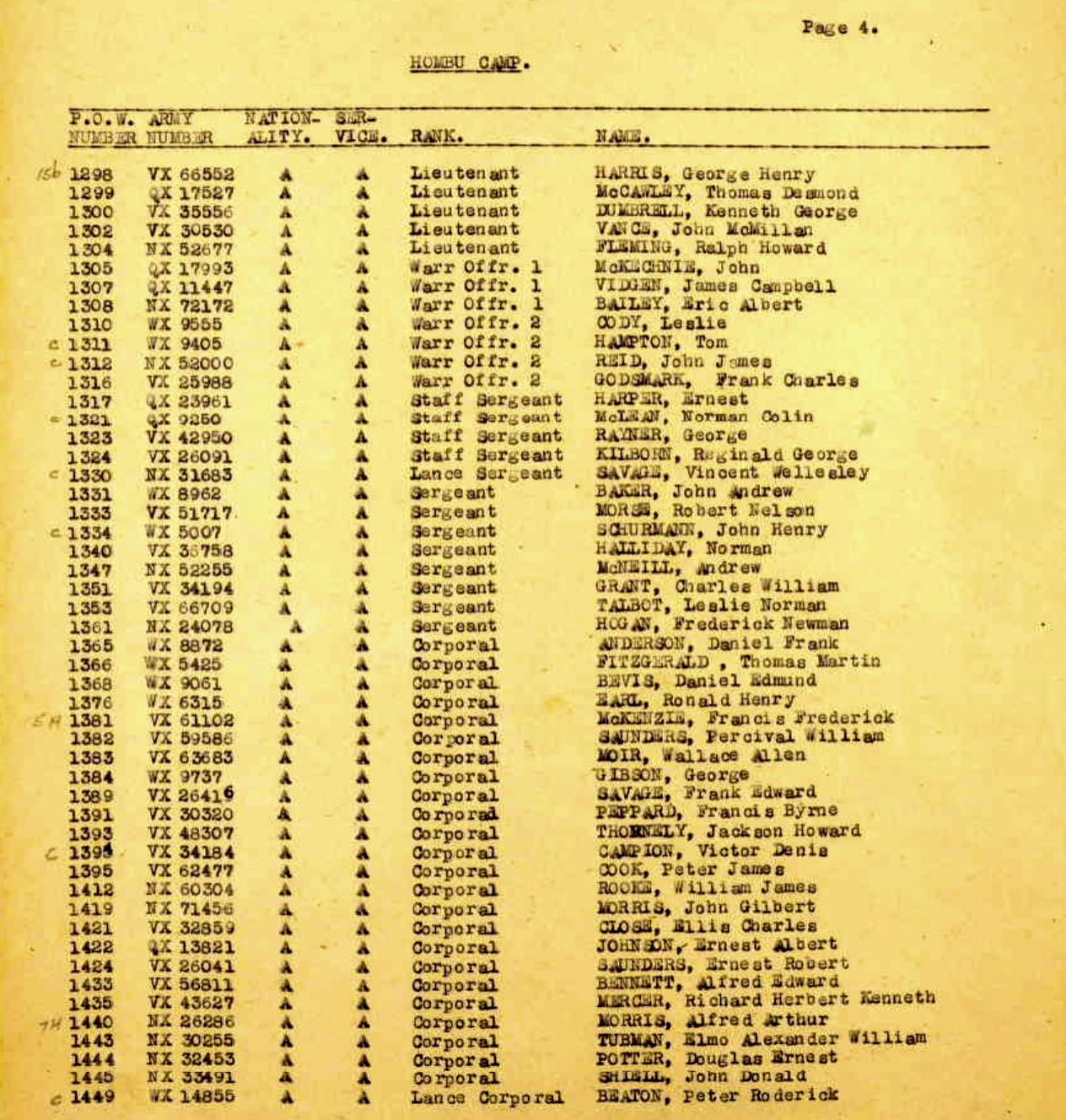
Also please read about the boys from Merredin
Today Danny’s grandson Sean Morton operates the general store Nextra in Merredin. Every year a few weeks prior to Anzac Day he fills the store’s front glass windows with 2/4th memorabilia in recognition of his grandfather Danny Bevis. In 2021 a woman called Debra, called into the store, introduced herself asking if she could take a photo. She was a relative of John Claire WX7163 of ‘C’ Coy. He was included in the ‘C’ Coy photo in the Nextra exhibition. Please view the stores exhibition
John Claire was tragically KIA at Hill 200, Ulu Pandan 11 Feb 1942.
Camp Locations:
- Selarang Camp Changi - Singapore
- Chungkai, 60k - Thailand
- Lopburi - Thailand
- Nacompaton, Nakom Pathom Hospital - Thailand
- Nakom Nayok, Nakhon Nayok - Thailand
- Petchaburi - Thailand
- Tamarkan, Tha Makham 56k - Thailand
- Aungganaung,105Kilo - Burma
- Kendau, Kandaw, 4 Kilo - Burma
- Khonkan, 55Kilo Hospital 360k - Burma
- Meilo, 75 Kilo, 340k - Burma
- Kachau Mountain Camp - Thailand
- Victoria Point, Kawthoung - Burma. \'A\' Force, Green Force No. 3 Btn
- Thetkaw 14 Kilo - Burma

